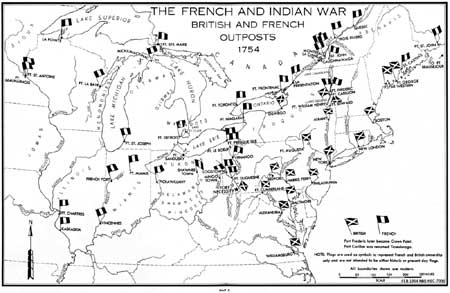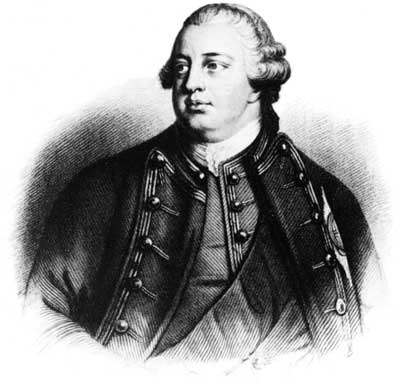|
FORT NECESSITY National Battlefield |
 |

(click on image for an enlargement in a new window)
The Braddock Expedition
THE BRITISH AGAIN CHALLENGE THE FRENCH. By the articles of capitulation signed on July 4, 1754, after the action at Fort Necessity, the French now hoped that further conflict in the trans-Allegheny region would be ended. The British, however, far from accepting the unfavorable outcome of that battle as a conclusive test of their strength on the frontier, soon began preparations to challenge again the French power west of the Alleghenies.
The renewed effort to drive the French from the Ohio, however, was not to be a Colonial undertaking. Governor Dinwiddie, attributing the defeat at Fort Necessity to lack of knowledge of French and Indian reinforcements at Fort Duquesne and to the indifference of certain colonies, particularly New York, in supporting the expedition against Fort Duquesne, now began preparation for a new campaign. On July 20, he ordered the enlargement of the post at Wills Creek. A log fort and a storage magazine, capable of holding provisions for 1,200 to 1,400 men over a 6-month period, were built.
With this greatly strengthened establishment, he planned to send some 900 men and 6 swivel guns under Colonel Innes across the Alleghenies in an effort to capture the French fort on the Ohio. The refusal of the officers of the Independent Companies of New York and South Carolina and the mutinous conduct of the Virginia troops compelled Dinwiddie to abandon his plan. The failure of support in his expedition against Fort Duquesne and the lack of Colonial cooperation reflected in the Albany Congress of 1754 led him to believe that only with aid from England could a Colonial force successfully deal with the French. The British Government, therefore, prepared an elaborate plan of attack. Four expeditions were projected against the French strongholds at Fort Duquesne, Fort Niagara, Fort St. Frederic (Crown Point), and Fort Beausejour, with the main thrust directed against Fort Duquesne.

The Duke of Cumberland.
From Cunningham,
Lives of Eminent Englishmen.
The Duke of Cumberland, Captain General of the British Army and soldier son of the King (George II), now took the initiative in promoting the British campaign against the French. He appointed Maj. Gen. Edward Braddock, an officer of 45 years' service and a veteran of the Coldstream Guards, to be in command of the Fort Duquesne expedition as well as of all British troops in America. With the 44th regiment under Sir Peter Halkett and the 48th under Col. Thomas Dunbar, augmented by Colonials mainly from Virginia and Maryland, Braddock had assembled a formidable force. Lt. Col. George Washington accepted a place on Braddock's staff as one of the general's three aides-de-camp.

|
|
Last Modified: Mon, Dec 2 2002 10:00:00 am PDT |


